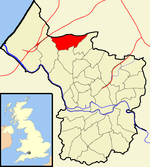Henbury Village Hall
1830 establishments in EnglandBristol building and structure stubsGrade II listed buildings in BristolHenburySchool buildings completed in 1830 ... and 2 more
Thomas Rickman buildingsUse British English from February 2023

Henbury Village Hall was built as a school in the Henbury area of Bristol, England. It was built in 1830 in a Tudor Revival style by Thomas Rickman, on the site of a charity school which had stood on the site since 1601. It has been designated by English Heritage as a grade II listed building.
Excerpt from the Wikipedia article Henbury Village Hall (License: CC BY-SA 3.0, Authors, Images).Henbury Village Hall
Church Close, Bristol Henbury
Geographical coordinates (GPS) Address Nearby Places Show on map
Geographical coordinates (GPS)
| Latitude | Longitude |
|---|---|
| N 51.506853 ° | E -2.631075 ° |
Address
Church Close
Church Close
BS10 7QF Bristol, Henbury
England, United Kingdom
Open on Google Maps






